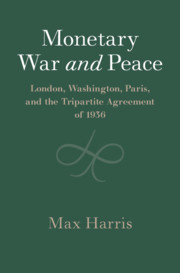Book contents
- Monetary War and Peace
- Studies in Macroeconomic History
- Monetary War and Peace
- Copyright page
- Contents
- Figures
- Tables
- Acknowledgments
- Abbreviations
- Introduction
- 1 A Classical Prelude, 1880–1914
- 2 Britain’s Biggest Blunder, 1914–1931
- 3 Hostilities Commence, 1931–1933
- 4 Washington Declares War, 1933–1935
- 5 Negotiating Peace, 1935–1936
- 6 A New Order, 1936–1939
- 7 Gold and Dollars, 1936–1937
- 8 Keeping France Afloat, 1937–1938
- 9 Battle for Sterling, 1938–1939
- 10 From Bretton Woods to Today
- Conclusion
- Book part
- References
- Index
- Series page
2 - Britain’s Biggest Blunder, 1914–1931
Published online by Cambridge University Press: 24 February 2021
- Monetary War and Peace
- Studies in Macroeconomic History
- Monetary War and Peace
- Copyright page
- Contents
- Figures
- Tables
- Acknowledgments
- Abbreviations
- Introduction
- 1 A Classical Prelude, 1880–1914
- 2 Britain’s Biggest Blunder, 1914–1931
- 3 Hostilities Commence, 1931–1933
- 4 Washington Declares War, 1933–1935
- 5 Negotiating Peace, 1935–1936
- 6 A New Order, 1936–1939
- 7 Gold and Dollars, 1936–1937
- 8 Keeping France Afloat, 1937–1938
- 9 Battle for Sterling, 1938–1939
- 10 From Bretton Woods to Today
- Conclusion
- Book part
- References
- Index
- Series page
Summary
This chapter recounts the breakdown of the international monetary system during the First World War and the subsequent reconstruction of the gold standard in the postwar decade, focusing on Britain's return to gold in 1925. Throughout the 1920s, central bankers cooperated with one another to guide the world back to gold, but fixed exchange rates and gold convertibility did not usher in nirvana. Britain, in particular, suffered from elevated unemployment and struggled to defend sterling's parity. London's decision to suspend gold convertibility in 1931 not only signaled the end of an era, but was to many countries the first salvo in what would become the monetary war.
- Type
- Chapter
- Information
- Monetary War and PeaceLondon, Washington, Paris, and the Tripartite Agreement of 1936, pp. 28 - 50Publisher: Cambridge University PressPrint publication year: 2021

